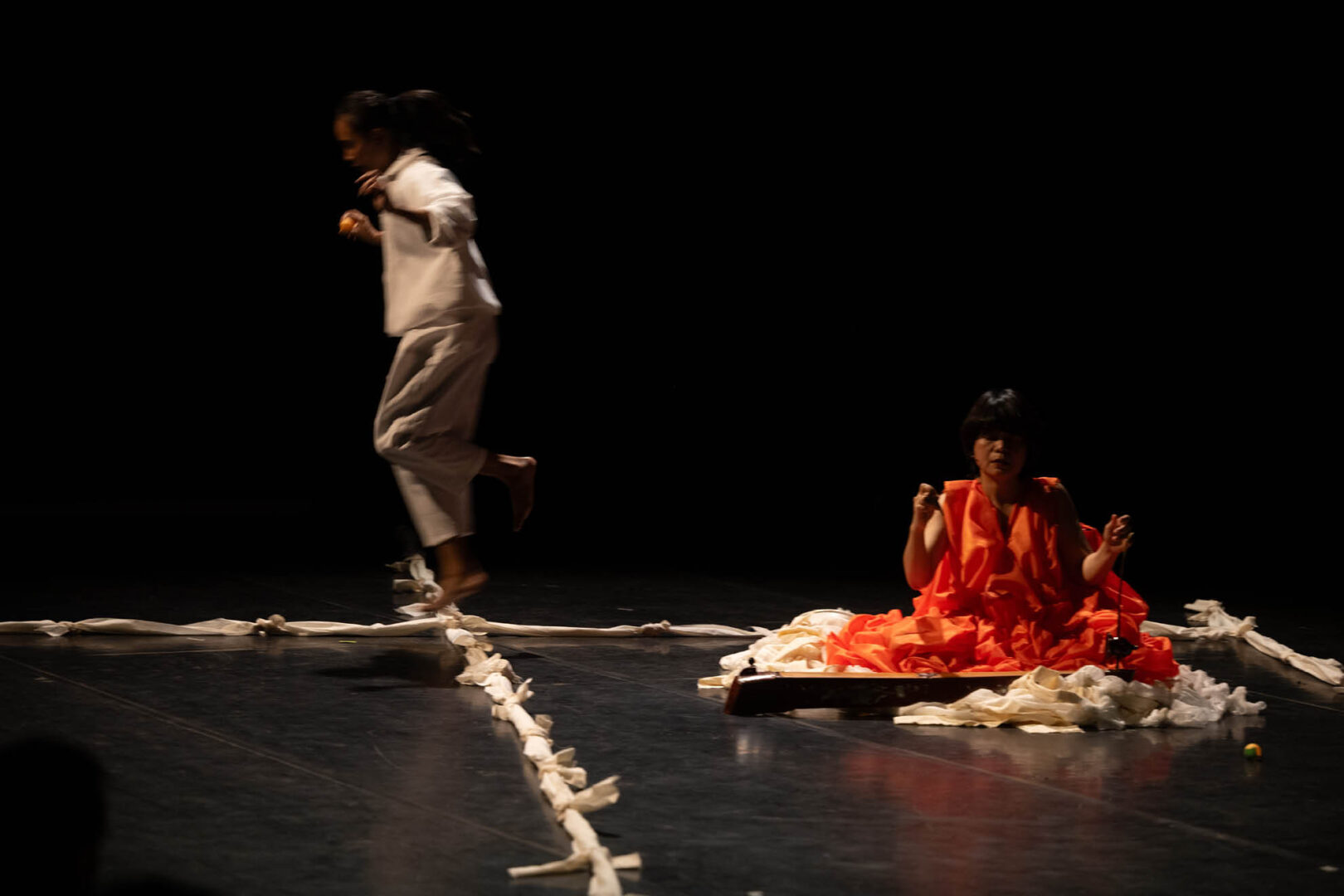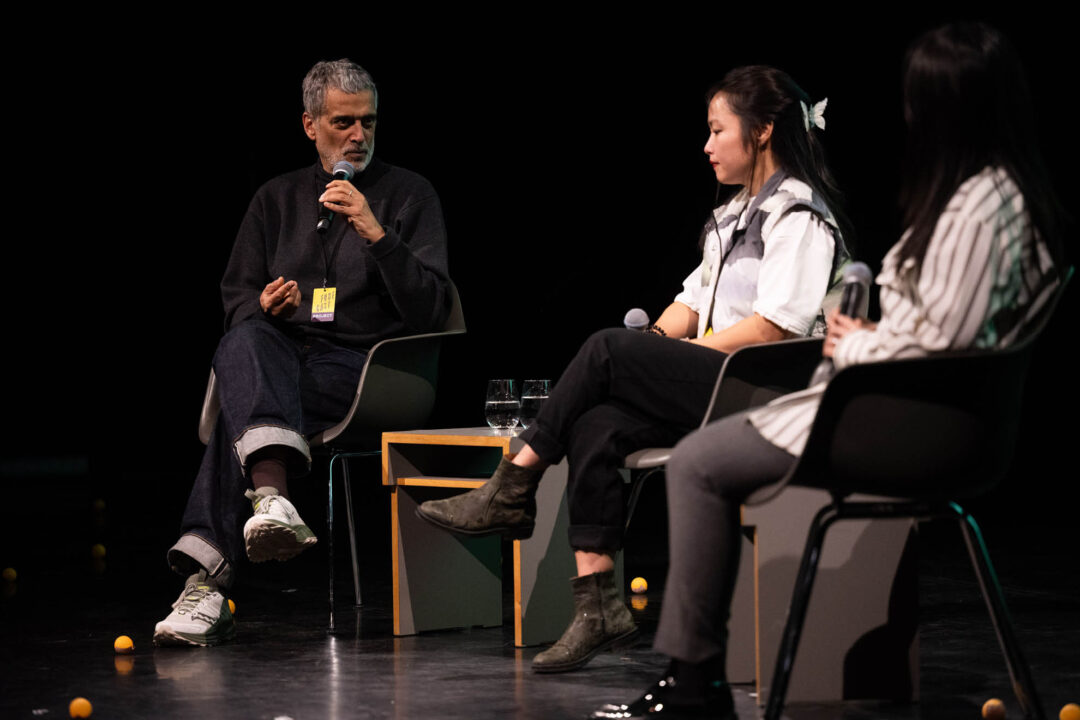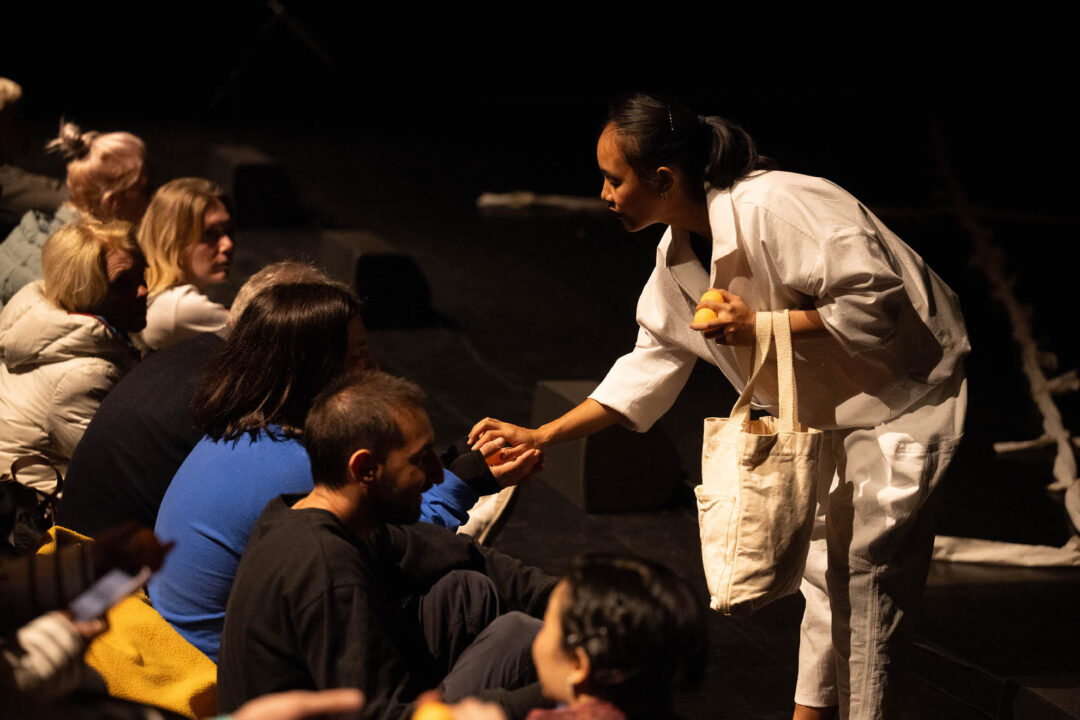Text: Xiaowen Zhu
Photos: Camille Blake

“There is no established framework for experimental theater in Vietnam,” Trà Nguyễn tells me, her voice carrying the weight of experience rather than complaint. It’s a statement of fact, one that underscores the precariousness of an artist working at the intersections of memory, identity, and performance in a country where infrastructure for such explorations is scarce. Yet this very scarcity fuels her resolve: not to conform but to create, stitching together a practice as layered and fragmented as the memories she seeks to unearth. At the heart of her work lies a paradox: a theater of slowness that demands immediacy, and an inquiry into memory that resists coherence. Nguyễn’s latest project, Mother Doesn’t Know Mnemosyne, is emblematic of this tension—a deeply personal yet universally resonant meditation on the fractured legacies of motherhood, history, and identity.
A Theater of Slowness
Nguyễn’s performances unfold with an intentional deceleration that defies conventional dramaturgy. If the frenetic pace of contemporary life urges us to consume stories quickly, her work asks us to linger. “Theater is not about events but about attention,” she says, distilling her artistic philosophy into a single, elegant statement. Her movements stretch time, creating a space where memory is not narrated but embodied, where silence speaks and slowness becomes an act of defiance. This approach finds its fullest expression in a method she calls verbatim bodies, in which characters are not imposed upon performers but emerge from their physical presence, as if the stage itself coaxes untold narratives from their being. Inspired by figures like Robert Wilson and Hans-Thies Lehmann, who defined postdramatic theater, Nguyễn rejects the actor’s role as a vessel for text. Instead, the body becomes an archive of memory, conjuring stories through gesture and stillness. Her work also draws from Jérôme Bel’s experimental choreography, which further informs her exploration of physical presence and layered narratives.
In Mother Doesn’t Know Mnemosyne, Nguyễn’s body becomes both the site and the subject of this inquiry. The work layers her personal history with archetypal narratives, drawing upon the Greek goddess of memory, Mnemosyne, as both a symbol and a guide. Just as Mnemosyne gave birth to the nine Muses, Nguyễn’s performance gives life to a multiplicity of stories, each fragmentary yet interconnected, resisting linearity in favor of a dreamlike multiplicity.
Threads of Personal and Collective History
Reading through Nguyễn’s script, I’m struck by a single, haunting image: a mother stitching garments she will never see completed. It is a metaphor for labor, separation, and the unseen threads that bind families across distances. She sewed clothing for unknown people. With machines. Automation. Each person only took up one part in the making of the clothes. She did the patching of major parts. She never knew how they looked as the final garment. She never saw anyone wearing them. For Nguyễn, this image is not abstract—it is her mother’s reality during Vietnam’s embargo period, when she worked in the USSR while Nguyễn and her brother grew up in Vietnam, navigating their concept of motherhood in her absence.
The play draws upon this history, weaving together personal memory and intergenerational trauma against the backdrop of Vietnam’s complex socio-political landscape. Yet Nguyễn resists the urge to turn the personal into spectacle. “It’s a play for my mother,” she explains, “filled with metaphors, symbols, and gestures that only she might fully understand.”
This intimacy, paradoxically, deepens the work’s universality. The specifics of Nguyễn’s story—her mother’s labor, her family’s separation, and the weight of history—become a lens through which broader questions emerge: How does memory shape identity? What is lost in translation between generations? And how do we reconcile the fragments of our past with the demands of the present?
Building a Future for Experimental Theater
The development of Mother Doesn’t Know Mnemosyne reveals Nguyễn’s engagement with the complexities of cross-disciplinary collaboration. During her mentorship with visual artist Theo Eshetu, Nguyễn shaped a performance that blends theatricality with visual art. The result is a stage transformed into an installation, featuring two large frames, a hopscotch pattern, and a monitor displaying pre-recorded narration. Nguyễn’s movements are repetitive and ritualistic, contrasting with the stillness embodied by her fellow performer, an instrumentalist. Together, they create a dynamic meditation on time, memory, and presence. At one point, the audience is invited to explore the stage themselves, shifting from passive spectators to active participants. This moment underscores Nguyễn’s philosophy of theater as a collaborative space where meaning is not imposed but discovered.


Her ambitions, however, extend far beyond the stage. In Vietnam, where experimental theater operates on the fringes, Nguyễn has focused on creating opportunities for independent performance. Each year, she produces two major projects: one a performance, the other a training or incubation program designed to support emerging artists. These efforts are shaped by her own journey—self-taught for two years before earning a scholarship to study dramatic writing at Carnegie Mellon University. This experience introduced her to frameworks unavailable in Vietnam, motivating her to build an ecosystem for experimental theater in her home country.
Memory as Resilience
Through Mother Doesn’t Know Mnemosyne, Nguyễn crafts a meditation on memory’s paradoxical nature—personal yet shared; fragmented yet whole. Her deliberate and introspective approach transcends traditional performance, creating a space where memory, healing, and identity intertwine across cultural and generational boundaries. The Berlin debut of Mother Doesn’t Know Mnemosyne adds a poignant layer of resonance. Berlin’s Vietnamese community, one of the largest in Europe, originated during the Cold War when East Germany recruited thousands of contract workers from Vietnam’s Communist government. Approximately half of these workers were women, housed in segregated communities and subjected to strict state controls and systemic racism. This fraught history of displacement and resilience provides a meaningful contextual backdrop for the presentation of Nguyễn’s performance in Berlin.
Nguyễn acknowledges the uncertainties inherent in presenting such a deeply personal piece. When asked about her expectations for the Vietnamese community’s reception of her work, she offered no definitive answers, instead inviting further reflection: How might diasporic audiences connect with the performance? Could those whose lives also bear the marks of dislocation find their own fragmented histories mirrored in her narrative?
Xiaowen Zhu is a bilingual author, curator, and artistic director based in Berlin and Manchester. She is the Director of esea contemporary and an advisor for the British Council’s Arts and Creative Economy Advisory Group.
You are currently viewing a placeholder content from Vimeo. To access the actual content, click the button below. Please note that doing so will share data with third-party providers.
More Information